The Huawei Honor 8 Review
by Matt Humrick on October 13, 2016 8:00 AM EST- Posted in
- Huawei
- Smartphones
- Mobile
- Kirin 950
- honor
Display
The Honor 8 uses a JDI (Japan Display Inc.) IPS-NEO LCD panel, just like the Huawei P9, which supports in-cell touch (the touchscreen layers are integrated into the display stack instead of existing as separate layers above the display) and panel self-refresh. The panel uses LTPS (Low Temperature Poly-Silicon) TFT technology that features higher carrier mobility than a-Si (amorphous silicon) TFT. This enables higher aperture ratios, allowing the panel to transmit light more efficiently, and because the drive circuits reside on the glass substrate, the black border around the display’s active area is thinner. This particular 5.2-inch panel has a resolution of 1920x1080, giving it a pixel density of 423ppi, which is plenty for an LCD display.
While the Honor 8 uses a high-quality panel, it requires proper calibration if it’s going to deliver excellent image quality. If Huawei fails to set gamma, white point, and RGB balance correctly, grayscale and color accuracy will suffer. To evaluate the display’s performance, we’ll use an X-Rite i1Pro 2 spectrophotometer for color measurements and an i1Display Pro colorimeter for luminance measurements, with SpectraCal's CalMAN 5 software managing the data.
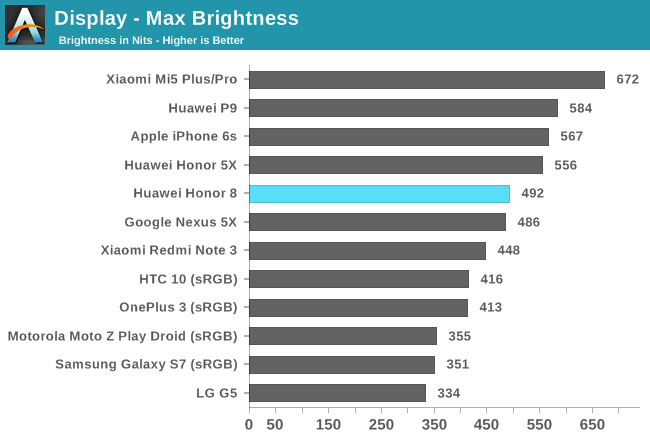
The Honor 8’s maximum brightness is just shy of 500 nits, a decent value that makes the display easy to see in most conditions except direct sunlight. It’s a little disappointing that it cannot match the 550 nit brightness of the less-expensive Honor 5X, and a little curious it falls noticeably short of the P9 with a similar display. The P9’s backlight uses 20 LEDs to increase peak brightness, so either the Honor 8 uses a different backlight assembly or our review samples are just at the extreme ends of hardware variability. At its lowest setting, the Honor 8 drops all the way down to just 3 nits, making it suitable for viewing in a dark room.
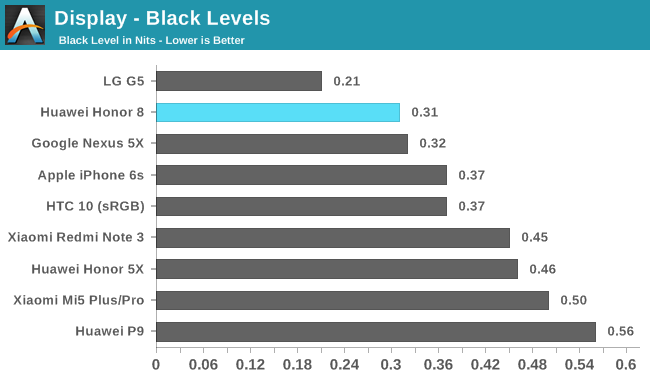
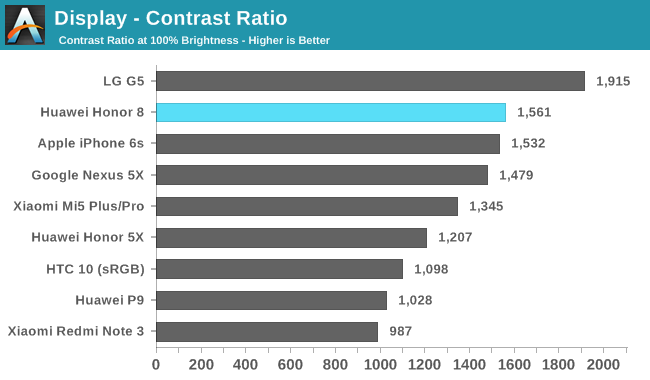
We measure the black level and contrast ratio at maximum brightness, which makes direct black level comparisons more difficult because a display’s black level increases with brightness; however, after normalizing for this effect, the Honor 8’s black level is about the same as the iPhone 6s’ and only slightly higher than the G5’s, giving it a very good contrast ratio overall. It appears the Honor 8’s display makes use of photo-aligned crystals and content-adaptive backlight control (CABC) to improve black levels.
The phones with OLED panels are not shown in these charts because they are able to achieve a black level of zero and a mathematically infinite contrast ratio by being able to completely turn off individual pixels.
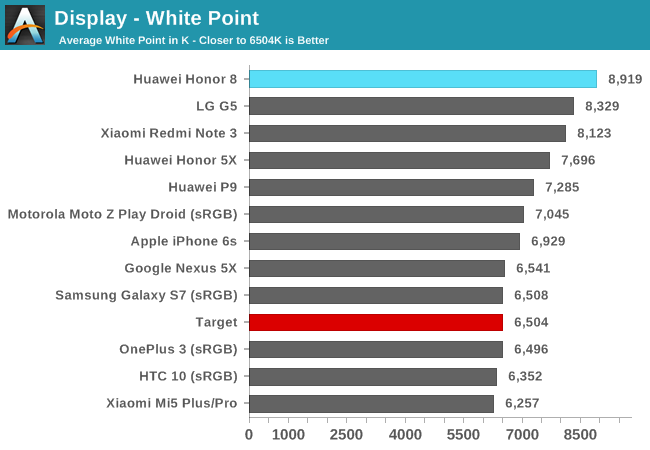
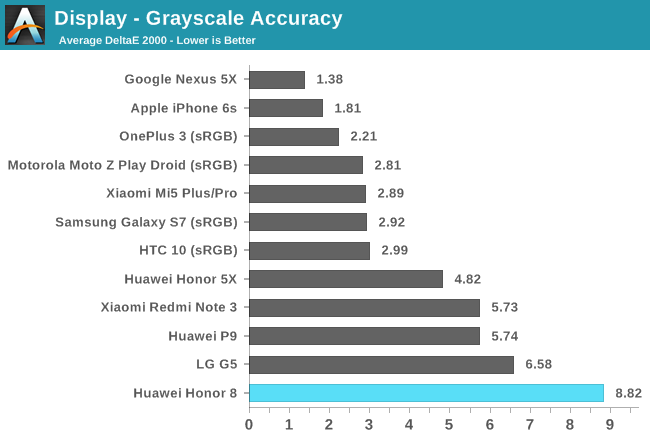
Unfortunately, Huawei continues to ship phones calibrated to an overly cool white point. The Honor 8’s “Default” temperature setting yields an average correlated color temperature (CCT) of almost 9,000K, which is even worse than the LG G5. The elevated levels for the blue and green primary colors and deficit in red give the Honor 8’s display a very obvious blue tint. If the display is not blue enough for you, however, there’s a “Cold” setting that increases the white point to about 9,500K. The “Warm” setting brings the average CCT down to less than 7,800K, but the emphasis on the blue and green primary colors at the expense of red gives the display an odd turquoise tint.
In addition to these three settings, it’s possible to select a custom white point target by dragging a finger around a color wheel. There’s no benefit in doing so, however, because the average CCT will not drop below about 7,900K and it’s impossible to correct the RGB imbalance that makes the screen look blue/turquoise.
The Honor 8’s average ΔE2000 grayscale error of 8.82 at its Default setting (Cold and Warm are even worse) is among the worst we’ve measured in the past few years, with a peak error of about 14 at 100% white. Gamma is a little high too, hovering around 2.3 over the full luminance range, reducing shadow detail and making images look a little darker than they should.
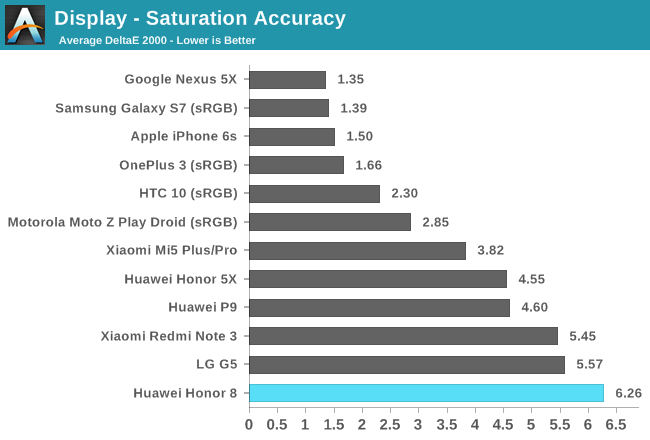
The Honor 8 uses a wide color gamut display that extends coverage for reds and greens but surprisingly comes up short for blues relative to the standard sRGB gamut. The larger gamut coupled with Android’s lack of color management means most colors appear oversaturated by as much as 20%. Shades of red are an exception, with lighter shades appearing undersaturated. Unfortunately, the Honor 8 does not have an sRGB mode, so there’s no way to improve saturation or color accuracy.
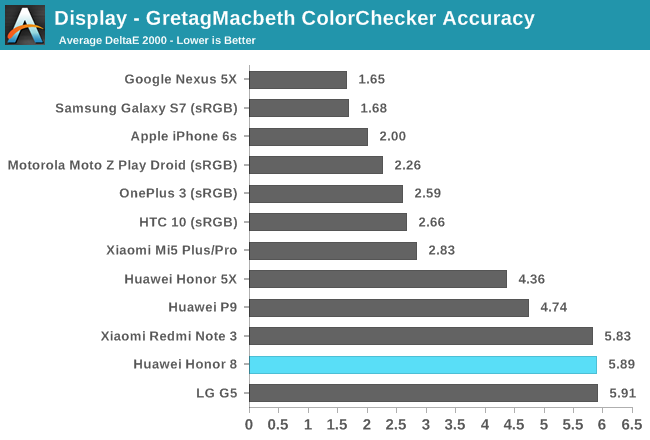
All three of the Huawei phones show poor color accuracy, which is no surprise considering the calibration issues each have with RGB balance and, to a lesser extent, gamma. The Honor 8 and P9 also have wide-gamut displays that oversaturate colors.
Regardless of the color temperature setting, the Honor 8’s display registers a ΔE2000 error above 3 (the threshold where error is generally considered unacceptable) for almost all of the tested colors. Skin tones are particularly bad, which is unfortunate considering how much time we spend using our phones to look at pictures of people. Average color error is similar to the LG G5 and the Xiaomi Redmi Note 3 that’s half the Honor 8’s price.
Many OEMs are now including special display modes that filter out blue light for use at night to reduce eye strain and improve sleep patterns. The Honor 8 includes Huawei’s “Eye comfort” mode for just this purpose, which is definitely warranted given its very cool white point. The RGB balance chart above shows how this mode restricts the blue primary’s output while boosting green and red. The result is a heavily yellow-tinted display with a warm 6000K white point. Grayscale and color accuracy are not the goal here, so we can ignore the grayscale error values. This mode is obviously not suitable for watching movies or viewing pictures; however, it is useful for reading text in low ambient lighting or before going to bed. It does take a few minutes for your eyes to adjust from the radical shift in white point, though.
Our review unit does not show any backlight bleed or issues with luminance uniformity, but its viewing angles are not as good as other IPS displays. In addition to the usual IPS glow at extreme angles, there’s a red-tinted sheen and reduction in brightness that shows up almost immediately when the screen is tilted or viewed off center. The effect is most pronounced when rotating the phone between portrait and landscape mode. It’s definitely something I notice during use, however, it’s not distracting enough to be a dealbreaker. Also, when viewing the display through polarized sunglasses, it remains viewable from all angles, but the screen looks dimmer and shows some slight discoloration in portrait mode (landscape mode looks fine).
For a phone that costs $400 or more, the Honor 8’s display fails to impress. It’s poorly calibrated, lacks an sRGB mode, and viewing angles are not what they should be for an IPS display. It does get reasonably bright and has good black levels, but that’s just not enough. The similarly priced OnePlus 3, for example, delivers rich, saturated colors in its default mode or very accurate colors in the well-calibrated sRGB mode. Huawei really needs to focus on display quality if it wants to compete with Apple and Samsung.


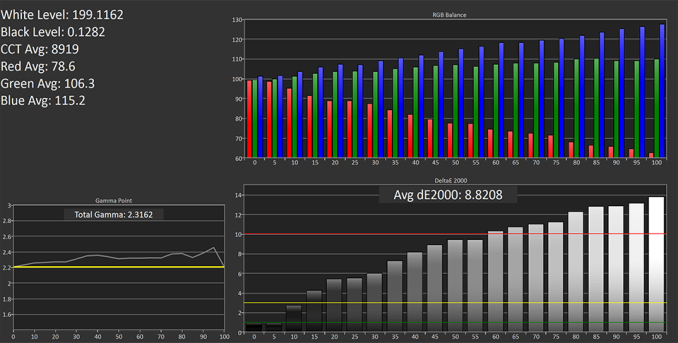

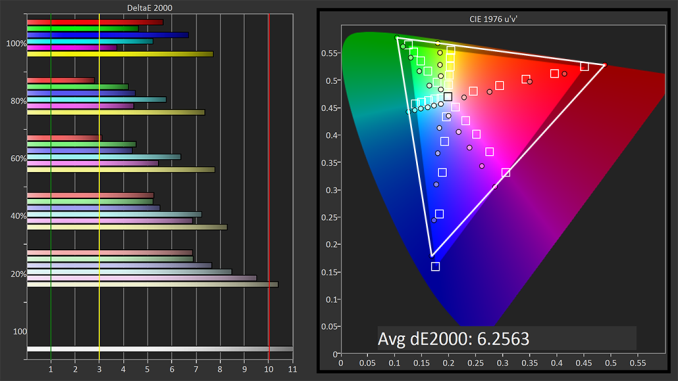
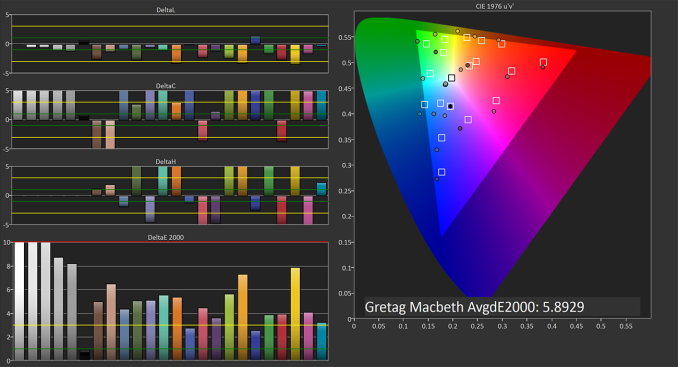

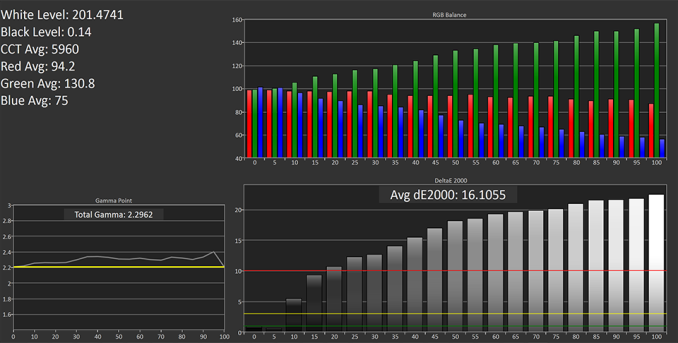








95 Comments
View All Comments
rarson - Wednesday, October 19, 2016 - link
Qualcomm is a company, not an SoC. Since you obviously missed his point, he was comparing compatibility of Qualcomm's Adreno graphics to ARM's Mali graphics.I own a phone with Mali graphics and I can attest that I have more compatibility problems with Mali than I've had with PowerVR or Adreno graphics.
tipoo - Thursday, October 13, 2016 - link
At least this goes for A72 cores rather than sprinkling 90 A53 cores in there.
Are all those cores needed, probably not, but at least it has some decent per-thread performance on the big cores to back it up.
s.yu - Thursday, October 13, 2016 - link
In the Chinese market, some will buy just because it's a Huawei. The stupid fanboys.UtilityMax - Thursday, October 13, 2016 - link
As opposed the highly educated people who buy LG, Samsung, or iPhones? Please. Is this why every grocery store or gym front desk clerk seems to be using a Samsung Galaxy or Apple?Ethos Evoss - Wednesday, October 19, 2016 - link
You sir are PROPER pathetic/naive person!Fidelator - Wednesday, October 19, 2016 - link
Sir, you are poorly educated yourself, read the review before commenting, the CPU in the Kirin is both faster and more efficient then the one in the 820The_Assimilator - Thursday, October 13, 2016 - link
Maybe because IT'S A F**KING PHONE.BrokenCrayons - Thursday, October 13, 2016 - link
One time I spent the afternoon screaming at my dresser for its lack of GPU power. It was several hours later and with a hoarse voice that I sheepishly realized I should probably have been screaming at my desktop PC instead. The neighbors heard my ravings through the wall. I don't think they want to talk to me anymore and it feels awkward when I come home from work and we happen to cross paths outside.Thanks to people like The_Assimilator reminding us of reality, it probably won't happen here in AT's comments box.
tipoo - Friday, October 14, 2016 - link
That's pretty myopic. Improvements to the GPU just as well as the CPUs over the years in phones have allowed richer content. People were asking "Why this much power in a phone" for years, yet older models can struggle in new apps and rich internet media.
svan1971 - Thursday, October 13, 2016 - link
$